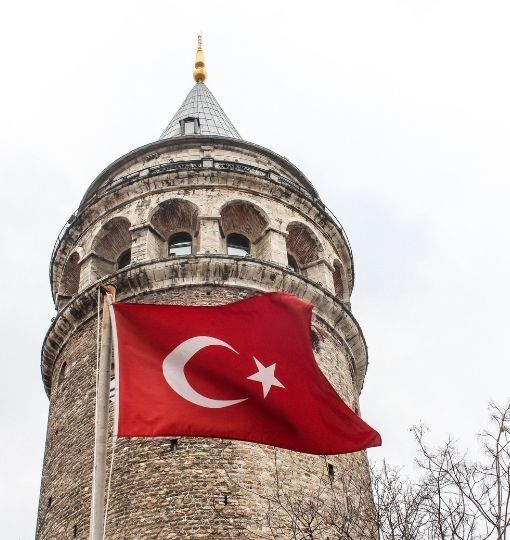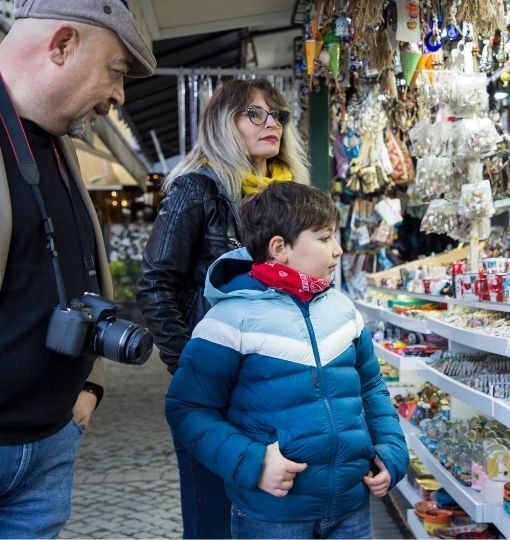Istanbul – a city of over 15 million where Europe and Asia meet – is a vibrant tapestry of history, food, and social traditions. From bustling spice markets to the serene Bosphorus shores, the city offers countless ways to experience its rich culture. But ask any Istanbul local, and they’ll tell you some of the most memorable nights here unfold around a meyhane table.
A meyhane is a traditional tavern-restaurant, and it’s where Istanbulites gather for good conversation, live music, and of course, endless food & drink. This is the heart of the city’s famed nightlife: not flashy clubs or pubs, but warm gatherings over classic dishes and the city’s beloved drink, rakı.
Turkish Rakı 101
Rakı – often enjoyed alongside an array of small meze dishes – is more than just an alcoholic beverage; it’s a social ritual. In the evenings, Istanbul’s neighborhoods come alive with clinking glasses and lively chatter from meyhane tables spilling onto sidewalks.
Friends and families sit for hours, slowly savoring bite after bite, sip after sip. It starts with a toast of “şerefe!” (cheers), and from there stories flow as freely as the rakı. By night’s end, you might hear folks singing old Turkish songs or see a few misty eyes as heartfelt toasts are made. Also, if you want to read about Turkish beers, here is a great guide for you on our blog page.
As an Istanbul local and rakı-lover myself, I can say there’s a special magic to these nights that capture the soul of the city. In this article, we’ll explore that magic: from what rakı is and why it’s cherished, to how to drink it properly, plus insider tips and the best places in Istanbul to immerse yourself in rakı culture (both traditional and trending in 2025). Afiyet olsun! (Bon appétit!) and let’s dive in.
What Is Rakı?
Rakı is an anise-flavored clear spirit distilled from grapes (fresh grapes or raisins) and commonly nicknamed “lion’s milk” for the way it turns a milky white when water is added. It belongs to the family of Mediterranean anise spirits (akin to Greek ouzo or French pastis), but has its own distinct character. A typical rakı is quite strong – usually about 40 – 50 % ABV – which is why Turks never drink it neat. Instead, rakı is almost always diluted with water (and then a couple of ice cubes), which magically transforms the transparent liquid into an opaque white drink (hence the “milk” nickname). This cloudy effect comes from the anise oil dispersing in water and is a signature trait of rakı.
Despite its punchy strength, a well-prepared rakı is smooth and richly aromatic. The flavor of anise (think licorice or fennel) is front and center, so the taste can be intense for first-timers. In fact, many newcomers find it a bit strong at first – but give it time. You can even have some Turkish tea in the middle to make your stomache calmer. As one expat humorously noted of her first try: “By my second glass, my mouth was numb and all was okay.” It’s true – rakı is an acquired taste that grows on you after a few sips! The drink is always served in slender, tall glasses, typically poured as either a tek (single, ~40 ml) or duble (double, ~80 ml) shot which is then topped up with cold water.
Properly prepared, it’s cool, refreshing, and pairs perfectly with food. But rakı isn’t just about what’s in the glass it’s also about how you drink it and with whom. In Turkey, rakı is never a quick shot at the bar; it’s an experience to be savored slowly in good company.
Rakı History and Importance in Turkish Culture
Rakı may be Turkey’s unofficial national drink, deeply woven into the social and cultural fabric of the country. It’s a tradition that dates back centuries. In the Ottoman era, Istanbul was famed for its meyhane culture – at that time, about one in three residents were non-Muslims (Greeks, Armenians, Jews), and these cosmopolitan taverns became meeting places where people of different nationalities gathered to drink and socialize.
Early rakı was often made in those taverns by distilling leftover grape pomace from winemaking with aniseed. By the 19th century, rakı had become a fixture of urban life in the Ottoman Empire, enjoyed in meyhanes alongside performances of fasıl (classical Ottoman music) and lively conversation.
After the founding of the Turkish Republic in 1923, rakı culture continued to thrive and even took on new symbolic importance. Mustafa Kemal Atatürk – the founder of modern Turkey – was famously fond of rakı, often enjoying it during dinner discussions that shaped the young republic. To this day many Turks affectionately refer to rakı as “Aslan Sütü” (lion’s milk), implying it’s a strong brew fit for the courageous, and indeed many legendary poets, musicians, and leaders have raised a glass of rakı. The drink came to embody the values of friendship, frank conversation, and hospitality. An old Turkish saying quips: “Rakıyı yalnız içen, ya delidir ya da derviş.” (Who drinks rakı alone is either crazy or a saint.)
Throughout the 20th century, rakı was produced and regulated by the state monopoly Tekel, cementing its presence in everyday life. Classic brands like Yeni Rakı became household names. Turks turn to rakı to toast big milestones, console friends after losses, and philosophize about life’s mysteries. A rakı table is sometimes jokingly called “Türkiye’nin küçük meclisi” (Turkey’s little parliament) because no topic – from football to politics to lost love – is off-limits.
Most importantly, rakı is a ritual of togetherness. Even as modern life accelerates, many still cherish the rakı sofrası (rakı table) as a moment to pause, bond, and celebrate being alive. In recent years, events like World Rakı Week have taken this heritage global, proving rakı is more than an alcohol – it’s a cultural icon and a source of national pride.
Rakı as a Culture in Istanbul: Tradition Meets 2025 Trends
Istanbul is the heart of rakı culture. An evening of rakı & meze can feel timeless, yet the scene keeps evolving. A classic Istanbul meyhane is unpretentious: checkered tablecloths, walls of old photos, and simple wooden tables crowded with plates and glasses. There’s soft Turkish music or live fasıl, and waiters with a sixth sense for refilling your rakı just in time.
Clinking rakı glasses is a nightly ritual of camaraderie. Every gathering begins with raised glasses and a resounding “Şerefe!” Locals will tell you a proper rakı night isn’t just about drinking; it’s about bonding. Strangers trade meze, friendships deepen, and stories gain sparkle in the glow of milky-white rakı.
The last decade has welcomed a wave of “new-generation” meyhanes. Places like Müşterek Meyhane blend vintage posters, curated playlists, and creative twists on mezes (think turmeric-spiced fava or calamari stuffed with Aegean herbs). The core ritual remains, but the vibe appeals to younger gastronomes. Stylish décor, rooftop terraces, even rakı cocktails at high-end bars now play a part in Istanbul’s ever-creative rakı scene. Women, once absent in old-timers’ tales, now enjoy rakı nights as comfortably as anyone, restoring the culture’s original cosmopolitan spirit.
Yet the essence never changes: the meyhane is a refuge from the rush, a place to unwind, connect, and savor life’s simple pleasures. Whether in a 120-year-old Balat tavern or a chic rooftop with a DJ, tradition and trendiness clink glasses in harmony.
Turkish Rakıs: Types, Brands & Regional Varieties
Turkey produces a dazzling array of rakı. Among today’s “big four” producers are Mey (makers of Yeni Rakı), Efe, Burgaz, and Tariş. Launched in 1937, Yeni Rakı remains the iconic benchmark – robust, slightly sweet, and ever-present. Connoisseurs rave about Tekirdağ Rakısı (especially oak-aged Altın Seri and single-region Trakya Serisi) for its refined smoothness. Efe shook things up with Yaş Üzüm Rakısı (fresh-grape rakı) and other creative lines.
Premium labels like Kulüp, Altınbaş (a potent 50 % ABV), and Sarı Zeybek (oak-aged with a whiskey-like finish) reward adventurous palates. Regional quirks include rakı infused with mastika (mastic gum) in the Aegean and sipping rakı with şalgam suyu (fermented turnip juice) in Adana. Turks debate their favorites much like wine lovers compare vintages – but all rakıs share the same goal: an anise-flavored embrace to elevate food and friendship.
Rakı Etiquette — How to Drink & Behave Like a Turk
For a first-timer, the world of rakı might come with a surprising number of “unwritten rules.” Turks take their rakı rituals seriously – not in a stuffy way, but in the sense of respecting a beloved tradition. Here are the essentials of rakı etiquette to help you drink like a local:
- Always dilute with cold water first, then add one or two ice cubes.
- Sip slowly; rakı is a marathon of conversation, not a sprint to the bottom of the glass.
- Serve others before refilling yourself — keeping friends’ glasses half-full is a sign of care.
- Clink the bottom of the glass, look your companion in the eye and say “Şerefe!”
- Eat, eat, eat. Pair every sip with cheese, melon or meze to keep the evening mellow and joyful.
- Stick to rakı. Mixing liquors is frowned upon and guarantees a morning headache.
- Keep the mood kind. Loud arguments, rushed departures or turning your empty glass upside-down are big faux-pas.
- Share your heart. Rakı encourages honest feelings — laughter, storytelling and even a happy tear are all welcome.
Tips for Tourists — Your First Traditional Rakı Night
If you’re a visitor eager to dive into an authentic rakı night, hoşgeldiniz (welcome)! Here are some tips to help you navigate and savor the experience like a local, so you leave with happy taste buds and even happier memories:
- Choose a true meyhane. Nevizade, Kumkapı or Kadıköy’s Çiya side streets beat the touristic traps every time.
- Gather a group, or be ready to be adopted by the next table — strangers turn into friends fast.
- Arrive after 20:00 and clear the evening; the best stories surface around hour three.
- Start with a colourful meze tray, then order hot dishes or rakı-balık (fish & rakı) later.
- Half-bottle (35 cl) rule: perfect for two or three; a full 70 cl suits four to six.
- Follow the rhythm — sip rakı, nibble meze, sip water, repeat.
- Leave space for fresh fruit and Turkish tea or coffee at the finale.
- Enjoy the roaming musicians, tip with a smile and join the chorus even if you only hum.
- Toast often. Extra points for learning “Sağlığına!” (to your health) or “Afiyet olsun!” (enjoy).
- Know your limit and hydrate — tahini-molasses or salty şalgam is the local hangover shield.
Best 5 Places to Drink Rakı in Istanbul (2025)
Istanbul has no shortage of fantastic spots to enjoy rakı, from historic taverns to modern eateries. Here are five top recommendations (a mix of local favorites and tourist-friendly options) for an authentic rakı night in 2025 – and yes, Kumkapı is on the list!
1. Kumkapı Meyhane District — lively, rustic, musical
A whole street of shimmering lights, fish platters and violinists weaving between tables. Anchor yourself at Kör Agop (since 1938) for legendary Armenian mezes and nightly fasıl. Expect dancing, hefty portions and a happy din until after midnight.
2. Tarihi Cumhuriyet Meyhanesi (Beyoğlu) — nostalgic heart of Taksim
Marble tables, black-and-white portraits, live strings and clarinet. Signature bites: mussel pilaki and paçanga böreği. When the whole room sings a classic anthem at 23:55, you’ll feel Istanbul’s soul.
3. Yakup 2 (Asmalımescit) — artsy courtyard charm
Dine under ivy and fairy lights where writers, actors and bohemians debate life. Try the rare topik or creamy Cretan meze, then toast “Şerefe, hayat!” (Cheers to life!) as the night breeze drifts through the trees.
4. Mükkellef Karaköy — modern rooftop with skyline views
Chef Arda Türkmen’s terrace pairs creative dishes (avocado ezme, Circassian-chicken pâté) with sweeping vistas of Galata Tower and the Bosphorus. Up-tempo playlists and polished service make it perfect for special celebrations.
5. Eleos (Beyoğlu) — Aegean-Greek elegance
White-and-blue décor, terrace over the Golden Horn and a menu of octopus salad, fried anchovies and fragrant Cretan ezme. Complimentary ouzo on arrival, but stay loyal to rakı as the lights of the old city glitter below.
Honourable mentions: Nomads Istanbul (a modern meyhane with Turkish shows), Safa Meyhanesi (120-year-old Yedikule gem), Agora Meyhanesi 1890 in Balat, and the Moda taverns of Kadıköy like Koço (Todori) or Samatyalı for Asian-side ambiance.
Comparisons — Rakı & Its Anise-Loving Cousins
You might be wondering how Turkish rakı stacks up against its cousins in neighboring countries – after all, the word rakı/rakia crops up in various languages, and Greece has the famous ouzo that looks pretty similar. It’s a great question, and one that locals love to discuss (often over a glass of rakı, of course!). Here’s a look at the differences and shared traits among these spirits and their cultures:
Greek Ouzo: lower ABV (≈ 40 %), single distillation, slightly sweeter herb profile, sipped seaside as an apéritif.
Balkan Rakia: clear fruit brandy (plum, grape, apricot), zero anise kick, enjoyed as a hearty shot at weddings and winter feasts.
Levantine Arak: almost twin to Turkish rakı, yet often homemade and triple-distilled; served with mezzes from Beirut to Amman.
Shared secret: all are drunk slowly with food, friendship and many toasts wishing good health.
Who does it best?
That’s subjective. Greeks will vouch for their ouzo and its smoothness with a plate of octopus and olives by the sea. Turks will argue nothing beats rakı with fresh fish and melon at a Bosphorus-side meyhane. Balkan folks will point out their fruit rakia is more natural – just pure fruit, no additives – and is the best winter warmer. In truth, each drink fits its context.
A cold ouzo at a Santorini sunset is perfect, just as rakı at an Istanbul tavern is perfect in its own scene. But one thing I always feel is that the cultures around these spirits are very much kindred. I’ve sat at tables in Athens and Izmir, in Sofia and Istanbul – different language flying around, different spices on the meze, but the essence is the same: raise a glass to friendship, nibble, chat, laugh, maybe even cry a little, sing a bit, and appreciate the moment. In a way, discovering rakı connects you to this whole constellation of traditions spanning from the Balkans to the Levant.
If you’re already familiar with ouzo or Balkan rakia, you’ll appreciate the nuances of Turkish rakı more, and vice versa. Perhaps the best is to try them all in their home settings. Just remember, while the drinks might differ in taste – the spirit of camaraderie and lingering over a meal is universal. So whether you say şerefe, yamas, or živeli, you’re partaking in an age-old human joy: sharing a drink to bring people closer together.
Istanbul Tourist Pass® — Your All-Access Key to the City
Istanbul Tourist Pass® bundles 100+ attractions, tours, and services into one digital pass, saving you time and money while you explore every corner of the city — including the best neighborhoods for a classic rakı & meze night.
Why Choose the Pass?
- Skip-the-Line Entry to icons like Hagia Sophia, Topkapı Palace, and the Basilica Cistern.
- Bosphorus Cruises (day, sunset, or night) — perfect for toasting “Şerefe!” as the skyline glows.
- Guided Walking Tour of Sultanahmet Highlights— discover the very streets where the city's old culture thrives.
- Audio Guides in English so you can explore at your own pace.
- WhatsApp Support from local experts weekdays 09:00–18:00 for instant help or restaurant tips.
Rakı-Friendly Extras
- Free Authentic Meze Tasting that introduces you to meze culture before your evening meyhane visit.
- Discounts on Nightlife Experiences such as party pub crawl experience where rakı flows freely.
- Flexible 1–5 Day Options — tailor the pass to match your travel (and meyhane) plans.
How It Works
- Buy online and receive a QR-code instantly by email.
- Activate on your first attraction visit or tour check-in.
- Scan & enjoy easy entries and audio-guided experiences, then spend your evenings sipping rakı like a local.
Tip: Pair your pass with a night in Kumkapı or Asmalımescit. Skip daytime ticket queues, save energy, then invest those extra hours in a long, unforgettable rakı table.
Istanbul Tourist Pass®; less time waiting, more time living the city you came to love. Cheers, or as we say, “Şerefe!”
A Final Toast
Discovering rakı means stepping into an Istanbul evening of music, laughter, salt-kissed flavors and unexpected friendships. Pour the water, watch the spirit turn to lion’s milk, and let the night unfold one slow sip at a time. Whether you raise your glass in bustling Kumkapı or under Karaköy’s starry roof, may your heart be light and your stories plenty.
Şerefe! Here’s to unforgettable Istanbul nights and the simple joy of sharing a table. Buy your Pass Now!


















